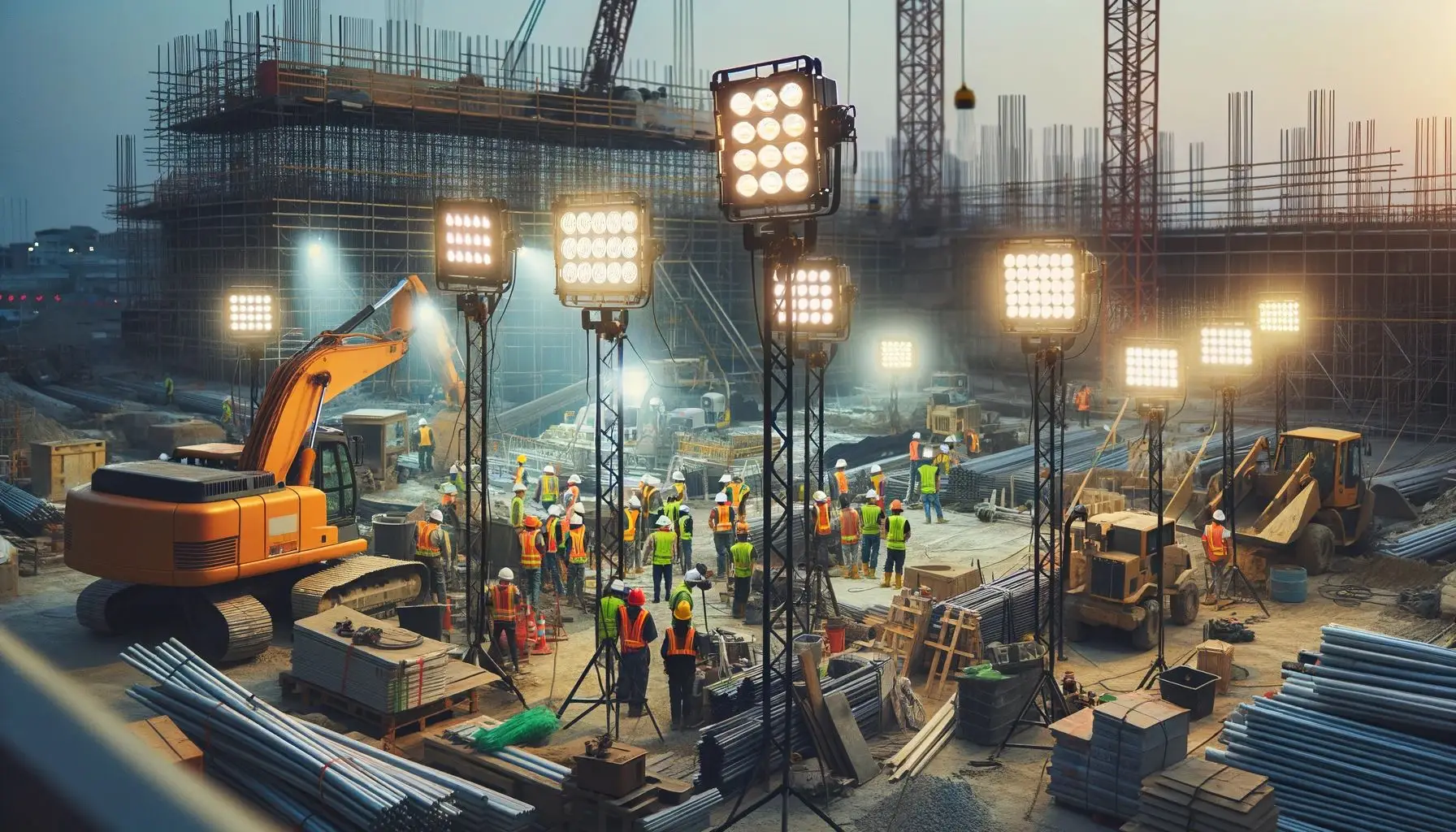Proper illumination is critical in commercial and industrial operations, directly impacting productivity, safety, and operational efficiency. In industrial environments where precision and safety are paramount, LED work lights are essential tools that facilitate continuous operations across various scenarios, from construction sites to manufacturing facilities.
This comprehensive analysis explores the technical specifications, applications, and strategic considerations for implementing commercial work lights. The guide examines various illumination solutions, including portable work lights for mobility-focused applications and robust temporary construction lights for large-scale project implementation.
Advanced Work Light Classifications
Portable Work Light Systems: Mobile Illumination Technology
Portable work lights represent the culmination of advanced lighting technology and practical engineering. Contemporary models incorporate sophisticated features that significantly surpass traditional halogen configurations in both efficiency and functionality. Read more about Illuminate Your Jobsite with High-Quality Portable Work Lights here.
Essential Technical Specifications:
– Advanced lithium-ion power systems
– Industrial-grade impact resistance
– Multiple illumination intensity settings
– Mounting configurations
– Environmental protection classifications
Temporary Construction Lights: Industrial Project Implementation
Industrial construction environments require temporary lighting systems that deliver consistent illumination while meeting rigorous safety standards. These temporary construction lights serve as critical infrastructure throughout the project execution phases.
Primary Implementation Scenarios:
– Commercial structure modifications
– Infrastructure development projects
– Industrial facility installations
– Emergency response operations
– Seasonal industrial applications
LED Work Light Technology: Professional Analysis
LED technology has fundamentally transformed industrial lighting applications, introducing unprecedented efficiency and reliability. Modern LED construction lights deliver multiple advantages in professional settings:
- Energy Management
– 75% reduction in energy consumption
– Optimized operational costs
– Enhanced sustainability metrics
- Structural Integrity
– Industrial-grade impact resistance
– Extended operational lifespan
– Reduced maintenance requirements
- Professional Safety Features
– Thermal management systems
– Environmental compliance
– Instantaneous illumination capability
 |
Selection Criteria for Work Lights
Environmental Analysis
Industrial work environments present diverse illumination requirements based on specific operational parameters. Selection criteria must align with particular application requirements and environmental conditions. Read more about How Long Do LED Lights Last? here
Critical Consideration Factors:
– Illumination coverage requirements
– Power infrastructure availability
– Environmental exposure conditions
– Operational duration specifications
– Mobility requirements analysis
Regulatory Compliance Standards
Professional work light selection necessitates a comprehensive understanding of applicable safety regulations and industry standards:
– UL/ETL certification requirements
– IP classification specifications
– OSHA regulatory compliance
– Hazardous location certifications
– Electrical specification compliance
Advanced Features in Professional Work Light Systems
Contemporary work light systems incorporate sophisticated technology that enhances functionality and operational efficiency:
Professional Connectivity Features
– Industrial IoT integration
– Programmable timing systems
– Remote management capabilities
– Performance monitoring systems
– Energy consumption analytics
Advanced Adaptation Systems
– Proximity detection technology
– Environmental light sensors
– Automatic illumination adjustment
– Emergency power systems
– Color temperature optimization
Investment Analysis and Return Metrics
Financial Implementation Analysis
LED work light selection requires a comprehensive evaluation of both initial investment and long-term operational costs:
- Capital Investment
- Operational Costs
- Maintenance Requirements
- Replacement Cycles
- Installation Requirements
Energy Efficiency Analysis
LED construction lights demonstrate significant advantages in professional applications through multiple efficiency metrics:
– Reduced annual energy expenditure
– Decreased environmental control costs
– Optimized maintenance schedules
– Reduced inventory requirements
– Enhanced sustainability metrics
Installation and Maintenance Protocol
Temporary Lighting System Implementation
Professional installation procedures ensure optimal performance and regulatory compliance:
- Strategic placement analysis
- Secure mounting implementation
- Power distribution protection
- Illumination level verification
- Redundancy system implementation
Maintenance Requirements
Portable work light systems require systematic maintenance protocols:
– Regular inspection schedules
– Connection verification procedures
– Power system maintenance
– Component integrity verification
– Emergency system testing
Frequently Asked Questions
Q: What is the expected operational lifespan of industrial LED work lights?
A: Industrial-grade LED work light systems typically maintain operational capability for 50,000+ hours under standard conditions, equivalent to approximately 5.7 years of continuous operation.
Q: Are portable construction lights suitable for professional industrial applications?
A: Contemporary industrial-grade portable work lights incorporate advanced power systems capable of delivering 8-12 hours of continuous illumination, meeting requirements for most industrial applications.
Q: What environmental protection rating is required for external work lights?
A: Commercial outdoor applications require minimum IP65 environmental protection ratings to ensure operational integrity against environmental elements.
Q: What are the temperature tolerance specifications for LED work lights?
A: Industrial-grade LED work light systems typically maintain operational capability within temperature ranges of -20°F to 120°F (-29°C to 49°C).
Q: What are the illumination requirements for construction environments?
A: OSHA regulations specify minimum illumination levels of 5 foot-candles (54 lumens/m²) for general construction areas, with task-specific requirements potentially necessitating higher illumination levels. Read more about Lighting Up Your Construction Site here.
Conclusion
Professional construction lights selection requires a comprehensive analysis of operational requirements, technological capabilities, and long-term cost implications. Through careful evaluation of specific application needs, technological options, and financial considerations, organizations can implement illumination solutions that optimize operational efficiency and safety compliance.
Effective illumination systems represent critical infrastructure that directly impacts operational safety and efficiency. Whether implementing portable work lights for dynamic requirements or installing temporary construction lights for large-scale projects, professional selection criteria ensure optimal system performance.
As LED technology continues to advance and smart systems evolve, professional work light capabilities will expand accordingly. Maintaining awareness of technological developments, implementing proper maintenance protocols, and evaluating system upgrades against operational requirements ensures continued optimization of illumination infrastructure.
Your message has been sent
